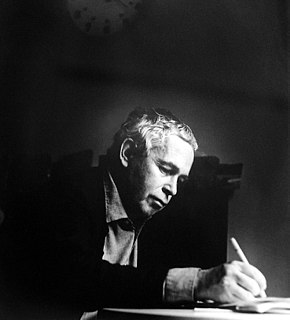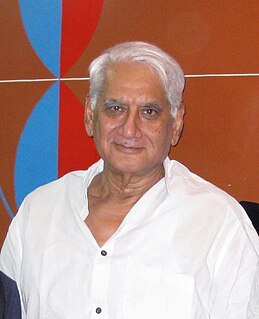
The Taj Mahal, is an ivory-white marble mausoleum on the right bank of the river Yamuna in the Indian city of Agra. It was commissioned in 1632 by the Mughal emperor Shah Jahan to house the tomb of his favourite wife, Mumtaz Mahal; it also houses the tomb of Shah Jahan himself. The tomb is the centrepiece of a 17-hectare (42-acre) complex, which includes a mosque and a guest house, and is set in formal gardens bounded on three sides by a crenellated wall.

Sir Edwin Landseer Lutyens was an English architect known for imaginatively adapting traditional architectural styles to the requirements of his era. He designed many English country houses, war memorials and public buildings. In his biography, the writer Christopher Hussey wrote, "In his lifetime (Lutyens) was widely held to be our greatest architect since Wren if not, as many maintained, his superior". The architectural historian Gavin Stamp described him as "surely the greatest British architect of the twentieth century".

Sir Gordon Howard Eliott Hodgkin was a British painter and printmaker. His work is most often associated with abstraction.

Charles Mark Correa was an Indian architect and urban planner. Credited with the creation of modern architecture in post-Independent India, he was celebrated for his sensitivity to the needs of the urban poor and for his use of traditional methods and materials.

The Rashtrapati Bhavan is the official residence of the President of India at the western end of Rajpath in New Delhi, India. Rashtrapati Bhavan may refer to only the 340-room main building that has the president's official residence, including reception halls, guest rooms and offices, also called the mansion; it may also refer to the entire 130-hectare (320-acre) Presidential Estate that additionally includes the presidential gardens, large open spaces, residences of bodyguards and staff, stables, other offices and utilities within its perimeter walls. In terms of area, it is the largest residence of any head of state in the world.

The India Gate is a war memorial located astride the Rajpath, on the eastern edge of the "ceremonial axis" of New Delhi, formerly called Kingsway. It stands as a memorial to 90,000 soldiers of the British Indian Army who died in between 1914 and 1921 in the First World War, in France, Flanders, Mesopotamia, Persia, East Africa, Gallipoli and elsewhere in the Near and the Far East, and the Third Anglo-Afghan War. 13,300 servicemen's names, including some soldiers and officers from the United Kingdom, are inscribed on the gate. Designed by Sir Edwin Lutyens, the gate evokes the architectural style of the triumphal arch such as the Arch of Constantine, in Rome, and is often compared to the Arc de Triomphe in Paris, and the Gateway of India in Mumbai.

Humayun's tomb is the tomb of the Mughal Emperor Humayun in Delhi, India. The tomb was commissioned by Humayun's first wife and chief consort, Empress Bega Begum, in 1558, and designed by Mirak Mirza Ghiyas and his son, Sayyid Muhammad, Persian architects chosen by her. It was the first garden-tomb on the Indian subcontinent, and is located in Nizamuddin East, Delhi, India, close to the Dina-panah Citadel, also known as Purana Qila, that Humayun found in 1533. It was also the first structure to use red sandstone at such a scale. The tomb was declared a UNESCO World Heritage Site in 1993, and since then has undergone extensive restoration work, which is complete. Besides the main tomb enclosure of Humayun, several smaller monuments dot the pathway leading up to it, from the main entrance in the West, including one that even pre-dates the main tomb itself, by twenty years; it is the tomb complex of Isa Khan Niyazi, an Afghan noble in Sher Shah Suri's court of the Suri dynasty, who fought against the Mughals, constructed in 1547 CE.

Connaught Place is one of the main financial, commercial and business centres in New Delhi, Delhi, India. Colloquially, and Connaught Place or CP are interchangeably used. It houses the headquarters of several noted Indian firms and is a major shopping, nightlife and tourist destination in New Delhi. It was designed by Robert Tor Russell. As of July 2018, Connaught Place was the ninth most expensive office location in the world with an annual rent of $1,650 per square metre ($153/sq ft).

The Masjid-i Jehan-Numa, commonly known as the Jama Masjid of Delhi, is one of the largest mosques in India.

The Red Fort or Lal Qila is a historic fort in Old Delhi, Delhi in India that served as the main residence of the Mughal Emperors. Emperor Shah Jahan commissioned construction of the Red Fort on 12 May 1638, when he decided to shift his capital from Agra to Delhi. Originally red and white, its design is credited to architect Ustad Ahmad Lahori, who also constructed the Taj Mahal. The fort represents the peak in Mughal architecture under Shah Jahan, and combines Persianate palace architecture with Indian traditions.

India Trade Promotion Organisation (ITPO), headquartered at Pragati Maidan, is the nodal agency of the Government of India under aegis of Ministry of Commerce and Industry (India) for promoting country's external trade. ITPO is a Mini-Ratna Category-1 Central Public Sector Enterprise (CPSE) with 100 percent shareholding of Government of India.

The National Handicrafts and Handlooms Museum (NHHM) commonly known as National Crafts Museum in New Delhi is one of the largest crafts museums in India. It is run by the Ministry of Textiles, Government of India. The museum is situated on the corner of the Pragati Maidan, facing the Purana Qila complex. In 2015, the Government of India announced that a Hastkala (handicrafts) Academy would be established in the Museum premises, converting some galleries into classrooms. Initial renovations destroyed one of the museum's most well-known artifacts, a room of murals painted by Madhubani artist Ganga Devi, leading to widespread criticism. As of 2019, renovations are still ongoing.
The Great Architecture of Mumbai blends Gothic, Victorian, Art Deco, Indo-Saracenic & Contemporary architectural styles. Many buildings, structures and historical monuments remain from the colonial era. Mumbai, after Miami, has the second largest number of Art Deco buildings in the world.
Raj Rewal is a leading Indian architect.

Anupama Kundoo is an indian architect.

Alan Gemmell OBE is the co-founder of FiveFilms4Freedom and former Director of the British Council in India. Gemmell was appointed as Chief Executive of the Commonwealth Enterprise and Investment Council in December 2018. Gemmell was appointed OBE in the 2016 New Year Honours List. Gemmell was included in the 2017 Financial Times Top 20 Public Sector LGBT Executives and in GQ magazine's 2016 List of the 100 Most Connected Men in the UK.
The Architecture of Delhi dates back more than a thousand years. As the capital of several great empires of India, including Rajput kingdom, Delhi Sultanate, Mughal Empire, and British Raj, the city of Delhi has been a centre for art and architecture.

The Palika Kendra is a 21-story building on Sansad Marg, New Delhi, India. Designed by Kuldip Singh and Mahendra Raj, it is among the few structures in Delhi that feature Brutalist architecture. After its inauguration in 1984 with a height of 91 metres (299 ft), it remained one of the tallest buildings in Delhi for years. It serves as the headquarters of the New Delhi Municipal Council and hosts the main server and the command and control centre of the civic body.
Narendra Dengle (1948-) is an architect, academician, and author based in Pune. His architectural designs have been a part of VISTARA in Paris as part of the Festival of India exhibition in 1986, and State of Architecture Exhibition in Mumbai in 2017-18. He has partnered and worked on various academic and architectural projects with Achyut Kanvinde, Vasanth Kamath, Romi Khosla, M.N. Ashish Ganju, and Kamu Iyer.















